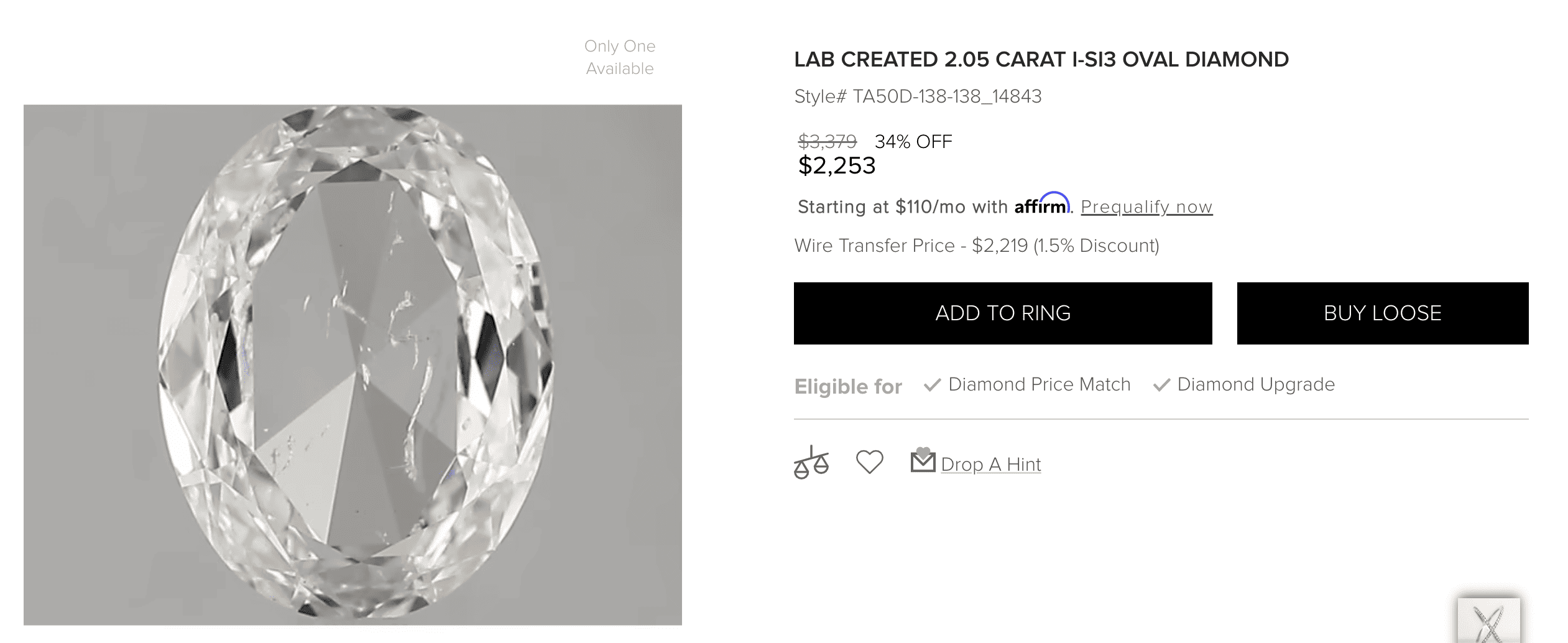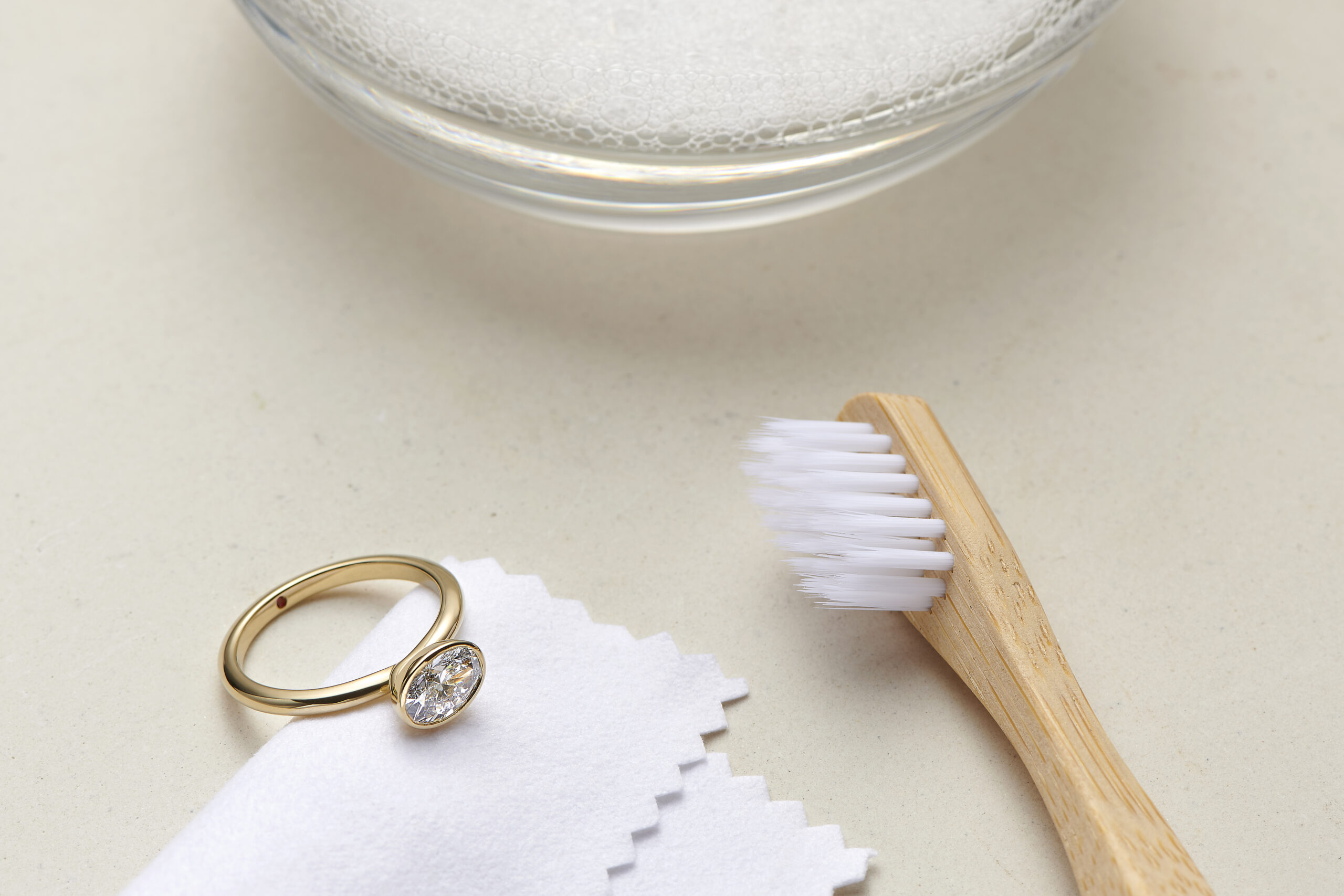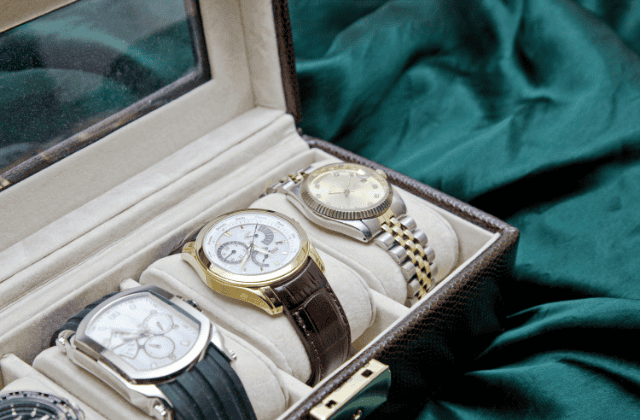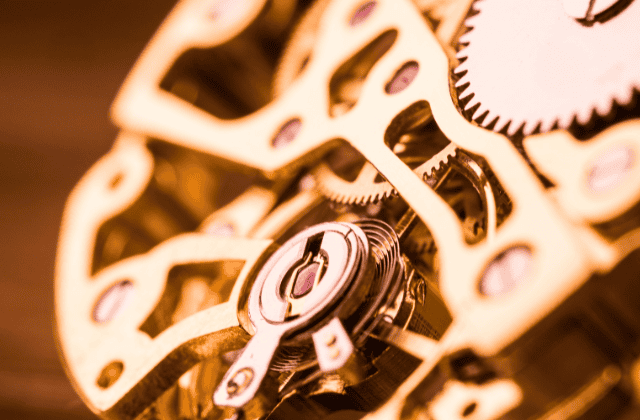Wanting to know more about an I1 Clarity Diamond?
You’re in the right place. In the guide, I’ll go over everything you need to know about an I1 clarity diamond and answer questions like:
- Are I1 clarity diamonds good quality?
- What is an eye clean diamond?
- Can I buy a lab-grown I1 clarity diamond?
What is an I1 Diamond?
An I1 clarity diamond is a diamond whose clarity grade has been assigned as Included (1). The Included clarity tier consists of three clarity grades: I1, I2, and I3 diamonds. The I clarity grade tier is the lowest clarity grades available in the industry.
Things to Know About Diamond Clarity
Clarity grades are given to diamonds based on the presence of inclusions and blemishes within a diamond. All diamonds get inclusions or blemishes, even lab grown diamonds. A diamond grader observes all of the characteristics in a diamond in order to give it a clarity grade.
Some of the details diamond graders from the Gemological Institute of America assess when determine diamond clarity include the:
- Size of the inclusions
- Type of inclusions
- Number of inclusions
- Location of inclusions
- Relief of inclusions (How it appears in relation to its light performance and background)
The GIA laboratory isn’t the only lab that grades diamonds, but they are the most reliable and respected. The AGS also is reputable, but they’re not as widespread as GIA certified diamonds.
The GIA Diamond Clarity Scale
The GIA set forth all the standards of diamond quality. They developed a system called the 4Cs of Diamond Quality. The system is the belief that diamond quality, price, and value are heavily impacted by the cut quality, clarity grade, color grade, and carat weight of the diamond.
Diamond cut, color, and clarity all have different grades given by the GIA. These scales and charts are used throughout the diamond industry worldwide.
These are the diamond clarity grades of the GIA clarity scale:
I1 Clarity Diamond vs I2 Clarity Diamonds
Though both an I1 diamond and I2 diamond are on the same I clarity tier, you’ll have a much harder time trying to find I2 engagement rings.
I1 engagement rings aren’t too hard to find, especially if you love shopping at mall jewelry retailers like Kay or Zales. Majority of the preset engagement rings in their shelves have I1 or SI2 clarity center stones. You won’t find an I2 clarity center stone in these stores either.
When I first started working at Kay’s, I remember being told to make sure to tell customers that we don’t carry any engagement rings below I1 clarity diamonds. As if it were something to be proud of, even though I1 is still a lower clarity grade.
But what they don’t tell you is that many of the smaller stones in your engagement rings are often I2 or I3 clarity. These diamonds are so small, you won’t be able to make out all the inclusions in them, but they may appear dull or cloudy from far away.

1 Carat I1 Clarity Diamond at 40x magnification

I2 Clarity Diamond 0.16 Carat
I1 Clarity vs SI2 Clarity
An I1 clarity diamond falls just beneath the SI clarity grades. The “Slightly Included” clarity tier consists of SI1 diamonds, SI2 diamonds, and on rare and unfortunate occasion, an SI3 diamond.
Both I1 diamonds and SI2 diamonds have noticeable inclusions when viewed with the naked eye. It’s almost impossible to find an I1 clarity diamond that is eye clean. It’s also less likely you’ll find an eye clean diamond with an SI2 grade.
But that doesn’t mean you can’t.
You’re way more likely to find an eye clean diamond among SI2 clarity diamonds if you have a bunch to choose from and are selecting a modest carat weight, like a 1 carat diamond.
The amount of inclusions present in SI2 diamonds are still noticeable, but they may not be littered throughout the entire diamond like with I1 clarity.
That being said, I1 clarity diamonds are typically less expensive than SI2 diamonds. If you’re on a tight budget, you might consider the cheaper option. But that doesn’t mean it’s the best diamond option.

I1 Clarity Emerald Cut Diamond

SI2 Clarity Emerald Cut Diamond
I1 Clarity Diamonds vs SI3 Clarity Diamonds
SI3 clarity grades are not a grade that you’ll find on the clarity scale of any reputable diamond grading report or laboratory.
The GIA has assessed what lesser labs have graded as SI3 diamond clarity and have determined these diamonds to be the same as I1 clarity diamonds.
So why do these other labs give out SI3 clarity grades?
One of two main reasons:
- They want to make it seem like you’re getting a deal on Slightly Included Diamond because it’s priced closer to an I1 or I2 diamond.
- They want it to seem like an SI3 diamond is better than I clarity diamond, and may even puff the price up more to seem like it’s a higher clarity grade than it is.
So if you ever see SI3 clarity diamonds, go the other way. Though their inclusions may be equal to an I1 clarity diamond, SI3 clarity diamonds are not official clarity grades.

I1 Clarity Diamond vs I3 Clarity Grade
I3 clarity diamonds are the lowest clarity grade available on the diamond clarity grading scale. They are two clarity grades below I1 diamonds. Like I2 diamonds, you shouldn’t find an engagement ring with an I3 clarity center stone.
An I3 diamond’s clarity has highly visible inclusions that impact both the beauty and durability of your diamond (if in a larger diamond). Typically smaller I3 diamonds won’t have that problem. Still, they may appear dull even if the diamond is so small you can’t make out the clarity grade.
An I1 engagement ring is much more common to find. Yes it’s more expensive, but it’s a lot more appealing than an I3 diamond, if you can find one of comparable size.
I2 and I3 Clarity Diamonds
How Much Are I1 Diamonds?
Being a lower grade on the diamond clarity scale, one might expect an I1 diamond engagement ring to be fairly cheap. In a way it is, when compared to VVS diamond clarity or internally flawless diamonds.
But diamonds aren’t graded on clarity alone. Just because a diamond has a higher clarity grade, doesn’t mean it’s guaranteed to be more expensive than lower clarity grades.
Diamond prices and values are based on a number of factors, not just the diamond clarity scale. It even reaches beyond the rest of the 4Cs. Though diamond clarity, carat weight, cut quality, and color grades make up the majority of the price, but it can shift costs based on other factors.
The other factors besides the 4Cs that can affect the price of an I1 clarity diamond include:
- Diamond shape
- Retailer/Brand
- Lab grown vs natural diamonds
- Diamond certification
- Specialty cuts (Super Ideal Cuts)
- Fluorescence
- Online vs in-store
For these reasons, it’s not promised that an I1 clarity diamond will be less than an SI2 diamond. If all other qualities are the same, than yes, that would be a reasonable assumption.
But if you had a 1 carat SI2 diamond with H color, it’s probably less expensive than a 2 carat I1 diamond with E color grades. The sad thing is, the SI2 diamond is a much better value and price-because 2 carat I1 diamonds are unappealing.

Lab Grown Diamonds with I1 Clarity
Usually lab grown diamonds are a great option when looking for higher clarity diamond grades because they come at a 20-40% discount than if you were to buy mined diamonds of the same quality.
You’d think it’d be safe to assume the same thing with lab grown I1 diamonds. Such diamonds are hard to find, because commercial lab grown diamonds that are highly included aren’t deemed as sellable.
Most retailers consider any diamond on the I clarity tier too low. A low clarity diamond is harder to achieve in lab grown diamonds, which is why you’ll typically see higher clarity grades with them.
Is an I1 Clarity Diamond Good for an Engagement Ring?
Though a diamond’s clarity grade doesn’t equate to its overall quality, I still wouldn’t buy an I clarity diamond. Darker inclusions rub me the wrong way, and I can still spot them even in a round diamond.
But not everyone is as sensitive to noticeable inclusions as I am. I couldn’t tell you how many people came storming back to Kay’s complaining about some black spot in their diamond that wasn’t there when they first bought it. They would swear up and down it wasn’t there when they bought it.
But it was. It always has been. Just sometimes you don’t notice until you find yourself staring your engagement ring, or when it comes back from the shop. That’s one reason we’re supposed to mark down the main inclusions on a job ticket-so they can’t claim we switched diamonds.
All I’m saying, is that I don’t recommend buying I clarity diamonds. Because I did.
My beloved Tolkowsky ring is a superior brand at Kay. It’s got a 1/3 carat I1 diamond in the center. Even at 1/3 of a carat, it has visible inclusions. I can see this big black spot right next to my prong.

My I1 Clarity Diamond Engagement Ring from Kay Jewelers
Thankfully, my round cut diamond looks beautiful outside because it is an ideal cut diamond. Only round cut diamonds can be ideal cut or excellent cut, but they can help hide noticeable inclusions when in the light.
If I could go back, I probably would have chosen a VS2 diamond. VS clarity grades seem to be the best diamond clarity grade for me because I don’t want to spend too long looking for an eye clean diamond.
But that’s just me. You don’t need to buy VS diamonds, but I definitely would stay away from I clarity diamonds. SI clarity diamonds can be a happy medium for you and make a stunning engagement ring you’ll love for years to come.








